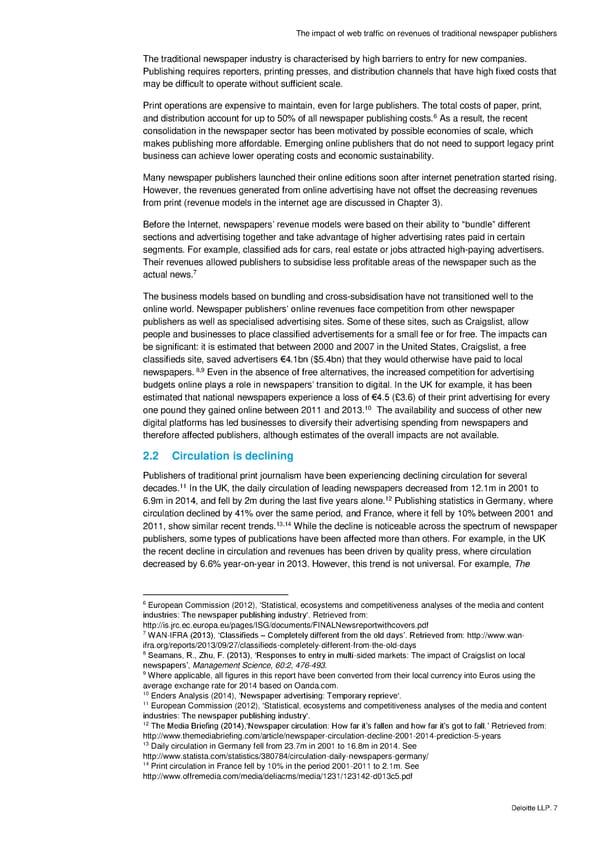The impact of web traffic on revenues of traditional newspaper publishers The traditional newspaper industry is characterised by high barriers to entry for new companies. Publishing requires reporters, printing presses, and distribution channels that have high fixed costs that may be difficult to operate without sufficient scale. Print operations are expensive to maintain, even for large publishers. The total costs of paper, print, and distribution account for up to 50% of all newspaper publishing costs.6 As a result, the recent consolidation in the newspaper sector has been motivated by possible economies of scale, which makes publishing more affordable. Emerging online publishers that do not need to support legacy print business can achieve lower operating costs and economic sustainability. Many newspaper publishers launched their online editions soon after internet penetration started rising. However, the revenues generated from online advertising have not offset the decreasing revenues from print (revenue models in the internet age are discussed in Chapter 3). Before the Internet, newspapers’ revenue models were based on their ability to “bundle” different sections and advertising together and take advantage of higher advertising rates paid in certain segments. For example, classified ads for cars, real estate or jobs attracted high-paying advertisers. Their revenues allowed publishers to subsidise less profitable areas of the newspaper such as the 7 actual news. The business models based on bundling and cross-subsidisation have not transitioned well to the online world. Newspaper publishers’ online revenues face competition from other newspaper publishers as well as specialised advertising sites. Some of these sites, such as Craigslist, allow people and businesses to place classified advertisements for a small fee or for free. The impacts can be significant: it is estimated that between 2000 and 2007 in the United States, Craigslist, a free classifieds site, saved advertisers €4.1bn ($5.4bn) that they would otherwise have paid to local newspapers. 8,9 Even in the absence of free alternatives, the increased competition for advertising budgets online plays a role in newspapers’ transition to digital. In the UK for example, it has been estimated that national newspapers experience a loss of €4.5 (£3.6) of their print advertising for every 10 one pound they gained online between 2011 and 2013. The availability and success of other new digital platforms has led businesses to diversify their advertising spending from newspapers and therefore affected publishers, although estimates of the overall impacts are not available. 2.2 Circulation is declining Publishers of traditional print journalism have been experiencing declining circulation for several 11 decades. In the UK, the daily circulation of leading newspapers decreased from 12.1m in 2001 to 12 6.9m in 2014, and fell by 2m during the last five years alone. Publishing statistics in Germany, where circulation declined by 41% over the same period, and France, where it fell by 10% between 2001 and 13,14 2011, show similar recent trends. While the decline is noticeable across the spectrum of newspaper publishers, some types of publications have been affected more than others. For example, in the UK the recent decline in circulation and revenues has been driven by quality press, where circulation decreased by 6.6% year-on-year in 2013. However, this trend is not universal. For example, The 6 European Commission (2012), ‘Statistical, ecosystems and competitiveness analyses of the media and content industries: The newspaper publishing industry‘. Retrieved from: http://is.jrc.ec.europa.eu/pages/ISG/documents/FINALNewsreportwithcovers.pdf 7 WAN-IFRA (2013), ‘Classifieds – Completely different from the old days’. Retrieved from: http://www.wan- ifra.org/reports/2013/09/27/classifieds-completely-different-from-the-old-days 8 Seamans, R., Zhu, F. (2013), ‘Responses to entry in multi-sided markets: The impact of Craigslist on local newspapers’, Management Science, 60:2, 476-493. 9 Where applicable, all figures in this report have been converted from their local currency into Euros using the average exchange rate for 2014 based on Oanda.com. 10 Enders Analysis (2014), ‘Newspaper advertising: Temporary reprieve‘. 11 European Commission (2012), ‘Statistical, ecosystems and competitiveness analyses of the media and content industries: The newspaper publishing industry‘. 12 The Media Briefing (2014),‘Newspaper circulation: How far it’s fallen and how far it’s got to fall.’ Retrieved from: http://www.themediabriefing.com/article/newspaper-circulation-decline-2001-2014-prediction-5-years 13 Daily circulation in Germany fell from 23.7m in 2001 to 16.8m in 2014. See http://www.statista.com/statistics/380784/circulation-daily-newspapers-germany/ 14 Print circulation in France fell by 10% in the period 2001-2011 to 2.1m. See http://www.offremedia.com/media/deliacms/media/1231/123142-d013c5.pdf Deloitte LLP. 7
 The impact of web traffic on revenues of traditional newspaper publishers Page 12 Page 14
The impact of web traffic on revenues of traditional newspaper publishers Page 12 Page 14